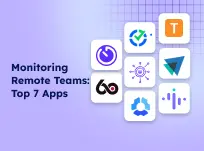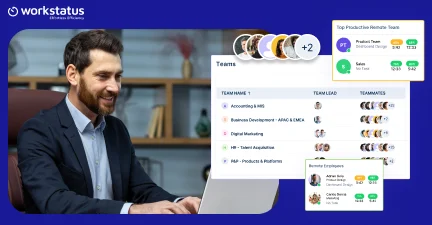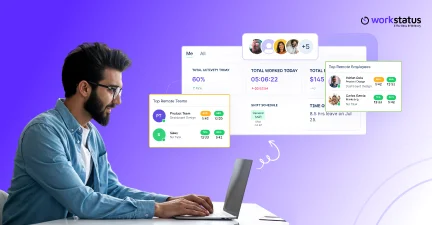Table of Contents
Introduction
Are you feeling stressed with the workload at the office? If yes, you’re not all.
Workload management is essential to hold your business processes together.
It’s critical to realize that effective task management is the key to increased productivity for both businesses and employees. This can prevent tension and burnout during the workweek.
Did You Know?
Employees experienced 70% less burnout after following workload management strategies at the workplace.
That’s why balancing your personal and professional life is much-needed and can boost overall well-being, happiness, and work productivity.
This blog provides helpful advice on becoming proficient at workload management, which will help you avoid burnout and work overload.
What Is Workload Management?
Workload management is basically the procedure of allotting tasks to keep employees and teams working at peak efficiency. It includes planning, scheduling, distributing, and monitoring workload to ensure team members attain their goals while evenly distributing work among them.
Here are some outcomes that you can achieve by implementing workload management systems:
- You will see better teamwork and collaboration within your company.
- Your team will deliver top-quality work while meeting deadlines.
- An employee will be productive while also balancing personal and professional responsibilities.
It might seem like a dream, but it’s a reality! By following the right tips, you can manage any workload management.
Adverse Effects Of A Heavy Workload
Taking on a substantial workload can showcase your dedication and value to employers. Hence, knowing your limits and striking a healthy balance in your work life is crucial. To do so, you must understand how an excessive workload can adversely affect you.
1. High Stress Levels
Feeling stressed at work occasionally is normal, but constant stress can take a physical toll, making your workload feel even heavier than it is. When overwhelmed, consider techniques like deep breathing exercises or taking short breaks to help you decompress and manage the stress.
2. Increased Mistakes
The more overloaded you are, the higher the likelihood of making mistakes at work. For instance, if you’re constantly rushing to meet deadlines, you might miss crucial details, make errors, or overlook important information. When you don’t have enough time to complete a task properly, you might skip the crucial step of cross-checking your work, leading to inaccuracies.
3. Poor Work-Life Balance
You might need to put in extra hours to meet a deadline or avoid falling behind, but maintaining a well-balanced workload is ultimately better for your overall well-being and productivity as an employee.
4. Burnout And Unhappiness At The Workplace
While the work needs to get done, there will be times when you feel overwhelmed and overworked. Being constantly overburdened with tasks can lead to burnout and dissatisfaction with your job. Taking necessary breaks, practicing self-care, and being kind to yourself during these periods are essential.
Different Types Of Workload Management Techniques
| Types of Workload Management | Description |
| Time-Based Workload Management | Focuses on managing the time spent on tasks and ensuring a balance between work and personal life. |
| Project-Based Workload Management | Involves managing the workload of a specific project by breaking down tasks, delegating responsibilities, and tracking progress. |
| Team-Based Workload Management | Focuses on managing the workload of a team by dividing tasks among team members, delegating responsibilities, and ensuring that workload is evenly distributed. |
| Role-Based Workload Management | Involves managing the workload of individuals based on their roles and responsibilities within an organization. |
| Technology-Based Workload Management | Utilizes technology and tools to manage and track overall workload, such as project management software, time tracking tools, and automation tools. |
How does Workstatus help manage workload management?
1. Workforce Optimization
Workstatus can help you optimize your workforce by scheduling the proper number of employees at the appropriate times. You can identify potential gaps or overlaps in coverage and make needed modifications to maximize your workforce via tracking personnel schedules and availability.
2. Employee Burnout
The platform allows you to monitor workloads and identify team members at risk of burnout. If an employee consistently works long hours or takes on too many tasks, Workstatus will flag this situation, enabling you to intervene and redistribute responsibilities or adjust schedules as needed. Preventing burnout helps maintain high productivity and employee satisfaction.
3. Overtime Tracker
Workstatus automatically tracks any hours worked beyond an employee’s regular schedule, giving you complete visibility into overtime costs. This information helps you manage your budget effectively and ensure compliance with labor laws and regulations regarding overtime pay and limits.
4. Task Management
Easily assign tasks to team members, set priorities, and track progress within Workstatus. This feature helps distribute workloads evenly, ensuring no one is overloaded or has too little to do. Clear task visibility also promotes accountability and helps you identify bottlenecks or areas where additional resources may be needed.
5. Time Tracking
With Workstatus’ time-tracking capabilities, you can accurately measure the time spent on various tasks or projects. This data provides insights into where your team’s efforts are being allocated, allowing you to make informed decisions about resource allocation and project planning.
5 Tips For Perfecting The Art Of Workload Management
Here are some tips for mastering workload management at the workplace:
1. Make Time to Plan
Understanding the value of planning tasks and projects in your personal and professional life is important. This includes setting an estimate for every activity, stating the start and end date, recognizing your tasks, offering correct descriptions, and categorizing them.
2. Decide Your Resource Availability
To maximize your time and talents, having full visibility of resource allocations to projects and tasks is vital. It becomes more difficult if you have several projects running simultaneously. If you have more than ten resources assigned to different projects, it’s time to invest in simple yet effective resource management apps.
3. Make a Capacity Plan
Capacity planning is the basis of effective workload management. Undoubtedly, employees who are overburdened are ineffective. On-time task distribution management can help you decide when more hands are necessary for the project.
4. Know your limits
Knowing your weaknesses and limitations can help you manage an intense job and provide a foundation for how much work you can accomplish. Try practicing self-awareness and taking periodic breaks to assess how your current burden affects you.
5. Estimate Tasks and Set Realistic Deadlines
Task estimation can help you and your team plan the project wisely and establish timelines. Everyone works at a different speed, so it’s important to know how long a certain task will take them to complete. Setting reasonable deadlines will give you better visibility and control over your team’s workflow. It also ensures that no team member is overworked or neglected, ensuring that no project will be left unattended.
The Path To Successful Workload Management: A Summary Table
| Stage | Description | Key Considerations |
| Assessment | Understanding current workload and resources | Identifying areas of inefficiency and excess workload |
| Planning | Developing strategies for effective workload management | Prioritizing tasks and delegating responsibilities |
| Implementation | Putting strategies into action | Automating processes, setting realistic expectations, encouraging employee feedback |
| Monitoring | Regularly reviewing and evaluating workload management effectiveness | Measuring results and adjusting strategies as needed |
| Continual Improvement | Continuously seeking ways to improve workload management practices | Staying informed on industry trends and best practices, seeking employee feedback |
Conclusion
All in all, no one is a superhuman who can work without breaks. Even if you try to overwork, failures are going to happen eventually. Certainly, achieving success in the workplace is essential, but you only get one life to enjoy to the fullest.
To strive in your career, never compromise your personal life or health.
A well-rounded employee who excels in personal and professional life requires a healthy work-life balance. However, you must work to achieve it and set a flexible schedule.
Thus, knowing what is required for a better work-life balance means taking the necessary steps to achieve it.
FAQs
Ques: How do you prioritize tasks in workload management?
Ans. With workload distribution, tasks are prioritized as per urgency, significance, deadlines, and dependencies. Effective management tools like Workstatus help categorize priority tasks efficiently.
Ques: What are the effects of poor workload management at work?
Ans. Poor project planning and workload management reduce team efficiency, mismanaged deadlines, more stress, burnout among teams, and compromised workflows.
Ques: How to manage employees who repeatedly exceed their workload?
Ans. It’s suggested that direct conversations be had with employees to learn about their drawbacks and potential solutions. Try balancing duties, adding resources, or changing project timelines. Bring a balance to work and help teams sustain productivity.












